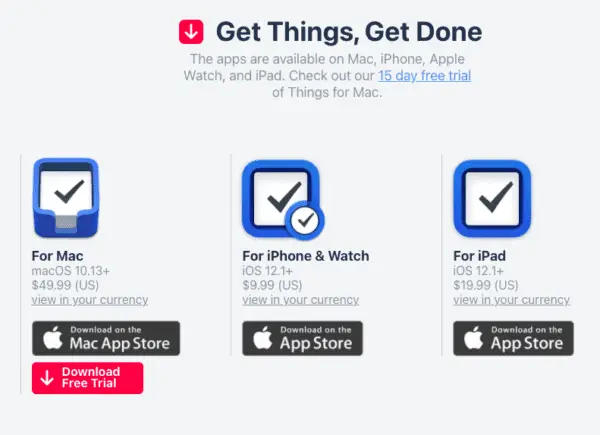

Todoist: You Decideįrankly speaking, Google Tasks is not there yet. The premium plan will cost you $36 annually for a single user, and $60 per user annually for enterprise users.
#Things vs todoist free
Todoist has a free plan with no labels, reminders or file uploads, and limited support for collaboration tools. It also has extensions for all popular browsers, smartwatches, and has plugins for Gmail and Outlook. Todoist is available on Android, iOS, Windows, and MacOS.
#Things vs todoist download
The app is free to download and use with no ads or in-app purchases. However, the web version looks a bit dated. Google Tasks is available on Android, iOS, and web browsers. You can customize Todoist with themes, change notification settings, and start a new page. Todoist will let you create custom filters so you can save your searches for the future. However, Google Tasks also lacks a basic search function to find buried/older tasks. Thereby making it easy to assign important docs and tasks to anyone in the team. You can add labels to each task which is helpful as you can use the same label for tasks that belong to different projects.įinally, moving forward with the spirit of collaboration, Todoist supports uploading files to individual tasks. You can assign priorities to tasks as well, so you know which one needs more attention.Ĭollaborating with others is easy as Todoist was built to be scalable and comes with an enterprise plan. Todoist understands natural language so if you type ‘remind me to call AB tomorrow at 5 pm’, Todoist knows what you mean. Let’s revisit the sidebar where you will find some default projects, to begin with, each color-coded. Todoist really picks up speed here and will soon leave Google Tasks behind. That’s rather odd since you can do that in the Keep app. One thing that really bugs me is that you can set a due date but not the time to tasks. Both subtasks and notes are visible on the main screen. You can then add notes to each task or subtask. This feature is useful when you are working on projects that require undertaking multiple tasks. In Google Tasks, tap on an individual task to create subtasks. This allows you to focus on what needs to be done now rather than loading you up with next week’s tasks. Todoist goes for the tried and tested sidebar menu where you will find a few options like Inbox, Today, and Next 7 Days which are self-explanatory. The menus at the bottom are easily accessible. Also, I don’t have to adjust my hands to reach the menu on the upper right corner every time I need to switch lists. I like this arrangement more because this way, the first thing I see is my list name and tasks. Note that the menu is located at the bottom and not on top or even in the sidebar. Google Tasks can handle many lists and tasks. There are some minor differences, but they are not significant enough to warrant another app. Once you begin using Google Tasks, you will realize that it works similarly to how tasks and lists work on Google Keep. You can easily reorder tasks by dragging and dropping them around, but there is more to them than what meets the eye. Todoist will offer you more options like adding labels, people, and setting a priority. Similarly, in Todoist, you will be greeted with a functional and material design where creating tasks is easy. Click on the ‘+’ icon while creating a new task to add a reminder or details.

Tap on Add a new task button to create your first task. Google Tasks is a minimalist looking app. On the other hand, Todoist is a fully-loaded to-do app that will let you create folders, assign tasks, and collaborate with team members. While there is a lack of advanced features, the question is if we really need them? Sometimes, more features can bog us down. Google Tasks is a minimalist app which lets you create tasks and assign dates to them.


 0 kommentar(er)
0 kommentar(er)
